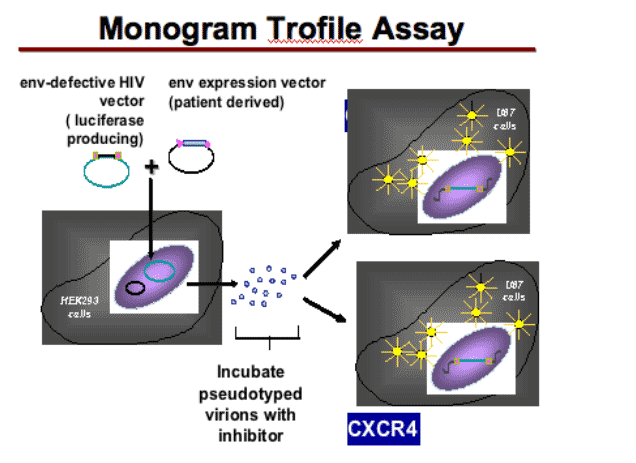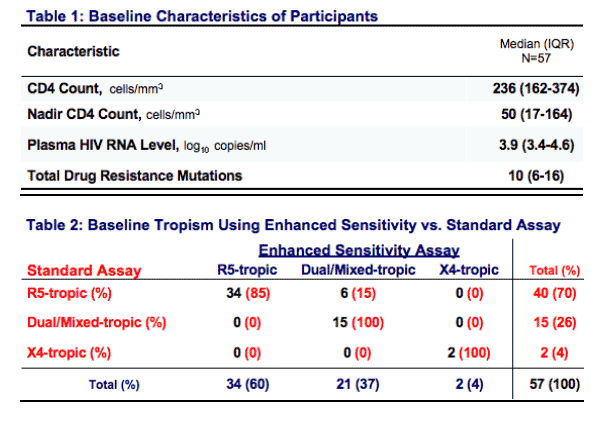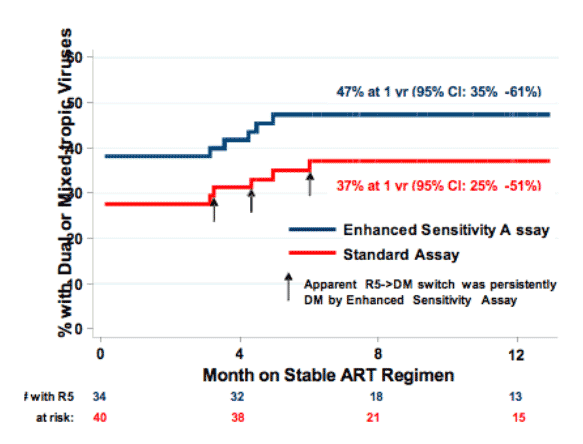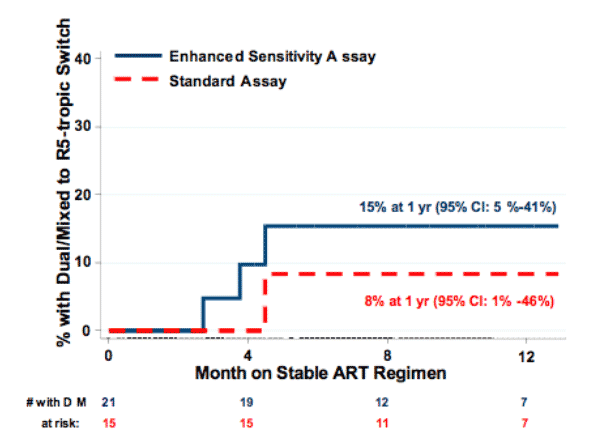 |
 |
 |
| |
Detection of Viral Co-receptor Tropism Changes with a High Sensitivity Phenotypic Assay among HIV-infected Patients with Drug-resistant Viremia
|
| |
| |
Reported by Jules Levin
15th CROI, Feb 3-6, 2008, Boston
PW Hunt1, JN Martin1, W Huang2, E Coakley2, D Han2, C Petropoulos2, M Bates2, R Hoh1, SG Deeks1, and J Reeves2
1University of California and San Francisco General Hospital, San Francisco, USA; 2Monogram Biosciences, Inc., South San Francisco, CA, USA
This work was supported by the NIAID (K23 AI065244).
BACKGROUND
~10% of treated patients with drug-resistant viremia harboring apparently purely CCR5-tropic viruses (R5) will have detectable CXCR4-using viruses on subsequent follow up with currently available assays.
Apparent "switches" from R5- to dual or mixed-tropic viruses (DM) between screening and enrollment have been associated with virologic failure of CCR5 inhibitor-based salvage regimens in clinical trials.
A pre-existing clinically significant minority CXCR4-using virus population, present below assay detection limits at screen, might account for these changes.
We hypothesized that improvements in assay sensitivity for CXCR4-using viruses might allow for earlier detection of DM-tropic viruses
CONCLUSIONS & IMPLICATIONS
The majority of apparent R5 to DM transitions detected with the currently available Trofile assay among treated patients are due to pre-existing minority CXCR4-using populations.
-- Use of a modified assay with enhanced sensitivity for CXCR4-using variants may improve the identification of patients who are unlikely to respond to CCR5 inhibitors.
Transitions between R5 and DM may still occur over time with the enhanced assay, but remain relatively uncommon.
The clinical significance of these presumably low-level shifts in CXCR4-using virus populations remains to be established in clinical trials.
METHODS
Chronically HIV-infected patients with drug-resistant viremia sampled from SCOPE:
--Clinic-based cohort study of >700 chronically-infected patients, half with drug resistance.
--Patient interview and biologic specimen archiving performed every 4 months
Patients meeting the following eligibility criteria were randomly sampled:
--Stable antiretroviral therapy regimen for ≥ 120 days prior to baseline.
-- ≥ 2 plasma HIV RNA levels above 100 copies/ml in 90 days prior to baseline.
-- Plasma HIV RNA level > 1,000 copies/ml at baseline.
-- Evidence of ≥ 1 major or minor genotypic resistance mutation (excluding L63P).
-- 1st plasma HIV RNA level post-baseline within 1.5 log10 copies/ml to ensure steady state.
-- ≥ 2 plasma HIV RNA levels > 1,000 copies/ml during observation.
Observations censored at the time of treatment modification

· Plasma viral co-receptor tropism assessed every 4 months until treatment modification with two versions of a recombinant virus assay (Trofile, Monogram Biosciences):
· Standard Assay (current clinically available assay)
· Enhanced Sensitivity Assay
· Conditions modified to increase sensitivity for CXCR4-using viruses, while maintaining specificity
· Lower limit of detection of minority X4 populations of 0.1% to 0.3% (Reeves, Poster #283, ICAAC, 2007).
Results

Fig. 1: Cumulative Probability of Detecting Dual/Mixed-tropic Viruses over Time
· Patients with R5-tropic viruses at baseline contributed a median of 3 tropism observations over 8 months.
· At 1 year, DM-tropic viruses had been detected in 37% by the standard assay and 47% by the enhanced sensitivity assay.
· Among those with baseline R5-tropic viruses, the risk of R5->DM switch at 1 year was:
· 15% (95% CI: 7%-32%) by the enhanced sensitivity assay
· 13% (95% CI: 6%-29%) by the standard assay
· 3 of 5 (60%) apparent R5->DM switches using the standard assay were detectable at baseline using the enhanced sensitivity assay.

Fig. 2: Time to DM->R5 "Reversion" with Enhanced Sensitivity and Standard Assays
· Patients with Dual/Mixed-tropic viruses at baseline contributed a median of 3 tropism observations over 9 months.
· The risk of "reversion" to R5 tropism at 1 year was:
· 15% (5% - 41%) with the enhanced sensitivity assay.
· 8% (95% CI: 1%-46%) with the standard assay
· 2 of 3 (67%) of apparent R5->DM "reversions" with the enhanced sensitivity assay switched back to DM by the next observation.

|
| |
|
 |
 |
|
|